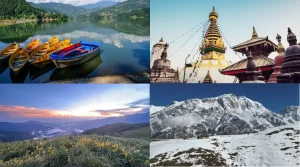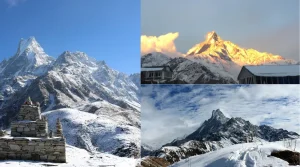Planning a trek to Mardi Himal Base Camp? Before you go, it’s important to know that there’s more than one way to get there. The Mardi Himal Trek is one of Nepal’s most rewarding short treks because it perfectly blends the rare mix of Himalayas and authentic cultural encounters. The Mardi Himal Trek Route consists of the classic route and alternative trails taking you there.
The classic mardi himal trek route is short, direct and popular, but the alternative routes to mardi himal add cultural depth, scenic diversity and different trail experience. From the tea garden of Lwang Village to the traditional villages of Ghandruk, each path has so much to offer. The classic route via Kande, Forest Camp and High Camp remains the most popular, whereas alternative routes like Sidhing, Lwang, Ghandruk, Landruk or Dhampus add variety to the experience. This guide to Mardi Himal Trek Route provides information of the classic and alternative routes to Mardi Himal, so you can plan your trek.
Why is it important to know the Mardi Himal Trek Route?
There’s no one way to experience the Mardi Himal Trek. Located on the east of Annapurna Base Camp route, this trail is less commercialized, making it perfect for trekkers seeking a peaceful walk in the nature. Routes matter because:
- The route you choose determines how challenging or easy your trek will be.
- The route determines the cultural experiences you’ll come across.
- The route can determine whether it is a long trek or a short one.
- Routes also influence the budget and time.
Understanding routes also helps to manage safety and difficulty. Having an option to choose the Mardi Himal Trek Route ensures a safe, enjoyable, and well-planned trek that delivers the experiences you value the most.
The Classic Mardi Himal Trek Route
The classic Mardi Himal Trek route is the most straightforward way to reach Mardi Himal Base Camp. It is the widely used trail and best for trekkers with limited time.
Route Overview
- The trek starts from Kande that can be reached by a 1-1.5 hour drive from Pokhara.
- Main stops: Kande- Australian Camp- Pothana- Forest Camp- Low Camp- High Camp- Mardi Himal Base Camp
- You can return via Forest Camp and descend towards Sidhing Village.
- The ending point of the trek is Sidhing Village , where you can get back to Pokhara via a jeep.
Key Features of Mardi Trek
The duration takes 5-7 days, where you can experience forests, ridges and alpine meadows along the trail. This trail highlights the view of Australian Camp, diverse landscape and also includes the stunning views of Machhapuchre and Annapurna South. This route is popular because it is the shortest and most direct route, making it an ideal choice for trekkers with limited time. This classic route to Mardi Himal is the best option for first timers who want the core experience of Mardi Himal Trek.
Alternative Routes to Mardi Himal Base Camp
The classic trail being the most common, there are several alternative routes that enhance the trek by adding cultural depth and variation in the experience. Beyond the standard route, these are the alternative route to Mardi Himal Base Camp that can be considered:
1. Sidhing Village Route
While this is the most popular route for descent, this is one route to Mardi Himal Base Camp. It’s full of stairs so it is popular for easy descent, while you are returning back. You come across farmlands, terrains and gurung settlements while walking on this trail.
This route highlights the authentic Gurung culture and the peaceful trails with fewer trekkers. There are homestays and teahouses to stop for lunch on the way. It takes 5-6 days to complete the trek.
Pros and Cons of Sidhing Village Route
The pros of this alternative trail includes the cultural richness that can be experienced. This route is also quieter compared to the classic descent and a great way to experience the village life and lifestyle of the region.
The cons can be the duration it takes as it is a slightly longer descent and consists of more rustic accommodation than the main trail. However this alternative trail is best for those who want a blend of scenery and culture.
2. Lwang Village Route
This is also another popular route of descent with similar duration as Sidhing Village trail. This trail passes through forests, river-side paths and tea gardens along the way.
This route highlights the local homestays and the cultural immersion that can be experienced while here. This trail has fewer tourists as many choose another route for descent. But, the riverside beauty and tea gardens are the main attractions of this route among the alternative routes to Mardi Himal.
Pros and Cons of Lwang Village Route
The pros of this route include the Lwang Village itself for the scenic and culturally enriching experience. The unique tea garden experience and the trail itself adds value to the trek as the route offers an off-beaten-path like feeling.
The opposite aspect includes that it has less infrastructure compared to the main trail. It also requires flexible planning for the transport back to Pokhara.However, this trail is perfect for trekkers seeking calm, cultural ending with natural beauty beyond mountains.
3. Ghandruk or Landruk Village Route
The Ghandruk or Landruk Village route is popular among the alternative routes to Mardi Himal. The trail connects Mardi Himal Base Camp with Ghanndruk and Landruk Villages. However, this is a longer trail than the classic route to mardi himal. The duration of the trek can be 7-8 days depending on the various factors.
This route highlights the Gurung Villages with traditional houses made of stones. It consists of the village trails, terraced fields and the rhododendron forests. The cultural depth and heritage along with the views of Annapurna feels like heaven.
Pros and Cons of Ghandruk/Landruk Route
This route is popular for its flexibility as it connects with many popular trails. It can be combined with the Annapurna Base Camp trek or the Poon Hill Trek. It provides a rich cultural experience and expands the journey beyond Mardi Himal.
As this trek is longer, it requires more time, not suited for those with limited time. Since, the distance and duration is added, the Mardi Himal trek difficulty can go beyond moderate. However, this route is best for those who want a longer journey and want to combine with other treks in the Annapurna Region.
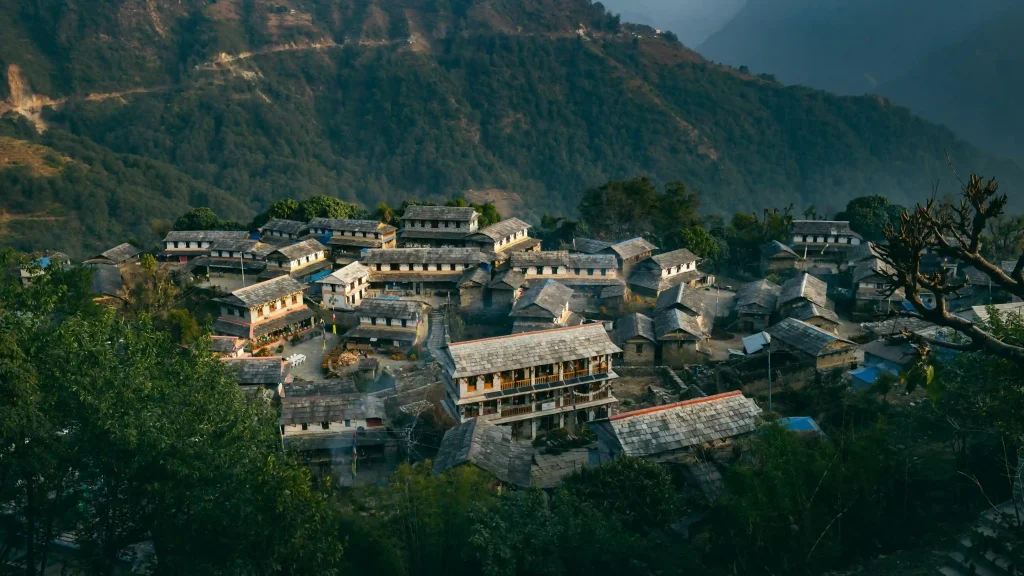
4. Dhampus Route
The Dhampus route begins at Dhampus instead of Kande and connects to Pothana. This route adds half to one extra day as compared to the classic route. You come across scenic ridges, terraced fields and beautiful villages along the way.
This route highlights the breathtaking sunrise and sunset views over Annapurna South. The path is also easily accessible from Pokhara and this is a gradual start to acclimatize where the beautiful village of Dhampus welcomes you.
Pros and Cons of Dhampus Route
The Dhampus route is popular for its softer introduction to the trails. The views are stunning and excellent for photography. This trail also adds variety to the beginning of the trek.
This trek can be slightly longer than the Kande start. Since Dhampus is a tourist hub, there are more trekkers on this route than others. This route is best for those who want a gentler start and enough time to enjoy photography spots.
The alternative routes to Mardi Himal not only offer variety but experiences much worthier.
Comparing the Mardi Himal Trek Route
As there’s no one way to experience Mardi Himal Trek, the classic route via Kande, and other alternative routes to Mardi Himal takes you to and around Nepal’s most photogenic mountain. Here’s a comparison among these popular routes:
| Route | Duration | Difficulty | Highlights |
|---|---|---|---|
| Kande Route | 5-6 days | Moderate | Forest, Ridges, Mt.Machhapuchre views |
| Sidhing | 5-7 days | Moderate | Gurung Culture and Homestays |
| Lwang Village | 6-7 days | Moderate | Tea garden and Riverside path |
| Ghandruk/Landruk | 7-8 days | Moderate/Difficult | Gurung Villages and extended trekking experience |
| Dhampus | 6-7 days | Moderate | Photography spots and Scenic Ridges |
Mardi Himal Trek Difficulty (Classic and Alternative Routes)
Mardi Himal Trek is considered as one of the short treks in Nepal for its moderate difficulty. This beginner friendly trek is suitable for both beginners with average fitness and experienced trekkers looking for a shorter adventure. The Mardi Himal Trek difficulty varies slightly depending on whether you take the classic route or the alternative routes.
- All routes are moderate in difficulty. However, the Ghandruk/Landruk route can be slightly challenging because of the extended duration.
- The highest point is the same for all routes, which is Mardi Himal Base Camp (4500 m).
- The hardest section is the steep climb from High Camp to Mardi Himal Base Camp.
- Alternative routes add cultural experience but not extreme difficulty.
- The Classic Route is more easier and direct compared to other routes.
- No route to Mardi Himal Base Camp requires technical climb because average fitness is enough.
The Mardi Himal Trek is accessible to most people with basic trekking experience and preparation. All of these factors make Mardi Himal Trek one of Nepal’s short trek choices for a fulfilling Himalayan Adventure.
Key Factors Affecting Mardi Himal Trek Difficulty
Mardi Himal Trek is considered a moderately difficult trek, but the level of difficulty you experience depends on the following factors:
- Altitude: The trek reaches up to 4500 m , so there are mild chances of altitude sickness.
- Weather: Cold temperatures at High Camp and Base Camp may add difficulty to the experience.
- Trail: Forests and the ridges can be muddy and slippery during Monsoon and Winter.
- Fitness Level: People with different fitness may experience different shades of Mardi Himal Trek Difficulty. Average fitness is enough but preparation helps.
The difficulty of the Mardi Himal Trek isn’t extreme, but factors like altitude, weather, trail conditions, pace, daily walking hours, and fitness level can shape the kind of experience you get.
Can we complete Mardi Himal Trek in 3 days?
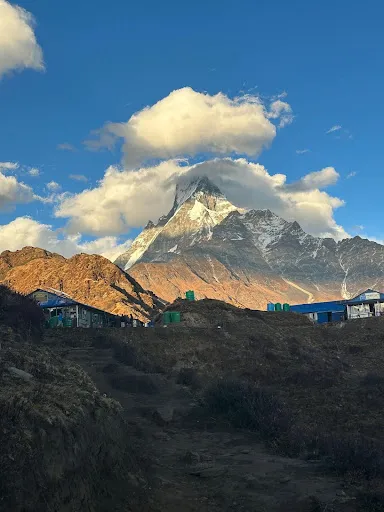
The Mardi Himal Trek takes 5-7 days usually to complete. If you are wondering if it can be completed in 3 days, the answer is YES. It is possible to complete Mardi Himal Trek in 3 days. It is challenging and not recommended for everyone.
Mardi Himal Trek in 3 days involves reaching Forest Camp on Day 1 , High Camp on Day 2 , Mardi Himal Base Camp and back to Pokhara on Day 3. Each day consists of long hiking days from 7-9 hours of daily walking. The challenges include the gradual increase in altitude increasing the risk of altitude sickness. It can be exhausting to walk long hours daily and this short 3 day trek comes with extremely limited time to enjoy the scenery.
Experienced trekkers and very fit individuals prepared for long hours of walking can attempt this trek. If you are someone with a very limited time, but determined enough to see the Mardi Himal Base Camp, then you can go for this short yet rewarding trek.
Permits Required for the Mardi Himal Trek
The Mardi Himal Trek requires the two main permits. Remember, these two permits are required no matter the trekking route you choose. These permits can be available from Nepal Tourism Board in Kathmandu or Pokhara. If you have booked from a registered trekking agency in Nepal, you don’t need to worry about your permits. The permits are:
- Annapurna Conservation Area Permit(ACAP) to help fund the conservation and maintenance of trails in the Annapurna Conservation Area.
- Trekkers Information Management System(TIMS) Card to register trekkers detail ensuring safety and co-ordination in case of emergencies.
These permits are valid for the entire Annapurna Region, so if you plan to combine Mardi Himal Trek to other trails in the Annapurna Region, then you don’t require additional permits.
Best Season for the Mardi Himal Trek
Choosing the right season also helps to reduce Mardi Himal Trek Difficulty. Mardi Himal Base Camp Trek can be done year round, but the best seasons are Autumn(September- November) and Spring(March-May). During this time, each route offers stable weather, clear skies, and enjoyable trekking conditions.
Autumn comes with crisp air and stunning views of mountains, while spring adds vibrant colors of blooming rhododendron along the trail. Winter trek is also possible, but the challenge is the freezing temperatures and snow covered trails. Monsoon is the least preferred season, as heavy rain, leeches and muddy trails makes trekking difficult with no proper mountain views.
Choose Autumn for the best visibility, Spring for the flowers and greenery and winter for solitude and challenge. It is recommended to avoid the monsoon if possible to experience the best of Mardi Himal weather.
How to choose the right Mardi Himal Trek Route?
When planning for your trip, choosing the right Mardi Himal Trek Route is the important part of your journey. Different routes offer different experiences and its better if you choose the one that suits the kind of experience you want to get:
- Classic Kande Route: This route is short and direct. If you are a first-time trekker or a beginner, this route is an ideal choice for you.
- Sidhing or Lwang Village Routes: These routes offer cultural immersion in Gurung villages where you can witness their lifestyle.
- Ghandruk/Landruk: This route makes the trek slightly longer in duration with heritage and scenic diversity to experience along the way.
Understanding what each classic and alternatives routes to mardi himal has to offer ensures you a trail that matches your fitness, interests, and also your time availability.
Final Thoughts on Mardi Himal Trek Route
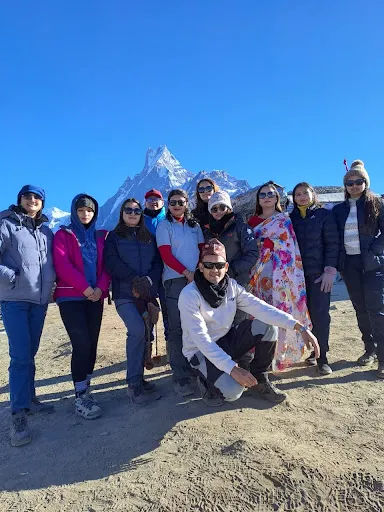
The Mardi Himal Trek is much more than just one of the short treks in Nepal. If any short duration trek offers stunning mountain views, cultural encounters and flexible trekking routes to suit every kind of traveler, then this trek is the one. The beauty of Mardi Himal lies in its versatility, no matter the trekking route you choose. Each trekking route of Mardi Himal offers you the same final reward, the Mardi Himal Base Camp(4500 m) ,Mardi View, Mount Fishtail and the awe-inspiring views of the Annapurna Range.
If you are short on time, stick with classic Kande Route and if you like cultural encounters, Lwang or Sidhing route may be right for you. The dhampus start is best for scenic photography spots while Ghandruk/Landruk is a mixture of all in a longer duration. Each path offers breathtaking views of the Himalayas and unique experiences and moments you can cherish for long after you return. Decide your route, prepare and embark on a journey you will never forget.
FAQs(Frequently Asked Questions)
1. Where does the Mardi Himal Trek start?
The Mardi Himal Trek usually starts from Kande, an hour drive from Pokhara. There are also alternative routes to Mardi Himal like Sidhing, Lwang Village, Dhampus and Ghandruk/Landruk start, which you can choose for unique experiences.
2. Where is the Mardi Himal Trek?
The Mardi Himal Trek is located in the Annapurna Region of Nepal. It is on the east of the popular Annapurna Base Camp Trail. It starts near Pokhara and goes up to Mardi Himal Base Camp(4500 m).
3. How hard is Mardi Trek?
The difficulty of Mardi Himal Trek is moderate as the trails are well-marked with staircases on most parts. Compared to other popular trek routes, Mardi Trek is shorter and less crowded, making it a beginner friendly trek in Nepal.
4. What is the difference between Mardi Himal Trek and Annapurna Base Camp Trek?
The Mardi Himal Trek is shorter, quieter, and less crowded, with stunning views of Machapuchare and Annapurna peak while, the Annapurna Base Camp Trek is longer, busier, and leads into the heart of the Annapurna Sanctuary with a more classic trekking experience.
5. Are there any villages and accommodations on the Mardi Himal trail?
Yes, there are villages, teahouses and lodges along the Mardi Himal Trail, including Dhampus, Pothana, Deurali, Forest Camp, Low Camp, where trekkers can stop for lunch or stay the night.
6. Which is the shortest route to reach Mardi Himal Base Camp?
The classic route that starts from Kande near Pokhara is the shortest and direct route to Mardi Himal Base Camp.
7. Is Mardi Himal Trek beginner friendly?
Yes, Mardi Himal Trek is considered beginner-friendly for those with moderate levels of fitness, as the trails are well-maintained, gradual altitude gain and accessible teahouses along the way.
8. Do I need a permit for the Mardi Himal Trek?
Yes, you need permits for the Mardi Himal Trek which are ACAP (Annapurna Conservation Area) permit, and a TIMS card, which can be obtained from Kathmandu and Pokhara.



